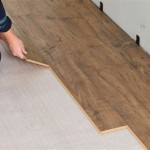Essential Aspects of Putting Down Flooring Underlayment
Flooring underlayment is a crucial part of any flooring installation. It provides support, reduces noise, and improves the overall comfort and longevity of your floor. If you're planning to install flooring, understanding the essentials of underlayment is key. Here's a comprehensive guide to help you navigate the process:
Types of Underlayment:
There are various types of underlayment available, each with its unique properties. Foam underlayment is a popular choice for its shock absorption and noise-reducing qualities. Rubber underlayment offers excellent sound insulation and is moisture resistant. Cork underlayment is environmentally friendly and provides thermal insulation. Choose the type that best suits your flooring and subfloor needs.
Thickness and Density:
The thickness and density of the underlayment impact its performance. Thicker underlayment provides more cushioning and sound insulation, but it can also affect the height of the floor. Denser underlayment is more durable and offers better support, but it may be more expensive. Consider the specific requirements of your flooring and subfloor when selecting the appropriate thickness and density.
Moisture Barrier:
Moisture can damage flooring and underlayment. If your subfloor is susceptible to moisture, choose an underlayment with a moisture barrier. This will prevent moisture from seeping into the underlayment and compromising its integrity.
Installation Techniques:
Proper installation is essential for optimal performance. Begin by preparing the subfloor by cleaning it and removing any debris or unevenness. Roll out the underlayment over the subfloor, ensuring that all seams are properly overlapped and secured with tape. Trim any excess around the edges.
Compatibility:
Not all underlayments are compatible with all types of flooring. Some underlayments may be designed specifically for certain flooring materials, such as laminate or hardwood. Check the manufacturer's specifications to ensure that the underlayment you choose is compatible with your flooring.
By considering these essential aspects, you can effectively put down flooring underlayment and enhance the quality and performance of your flooring installation. Remember to follow the manufacturer's instructions carefully and take your time during the process to ensure a successful outcome.

How To Install Underlayment And Laminate Flooring

How To Install Laminate Flooring The Home Depot

How To Soundproof A Floor With Sound Underlayment Installing Mat

Underlayment Buyer S Guide

Why Underlayment For Hardwood Floors Is Important From The Forest Llc

Cork Underlayment Installation Icork Floor

How To Prepare A Subfloor For Tile Installation The Home Depot

Underlayment What It Is And Why You Need Stuga

What Is A Moisture Barrier And When It Needed For Flooring Inc

How To Install Laminate Flooring For Beginners
Related Posts








